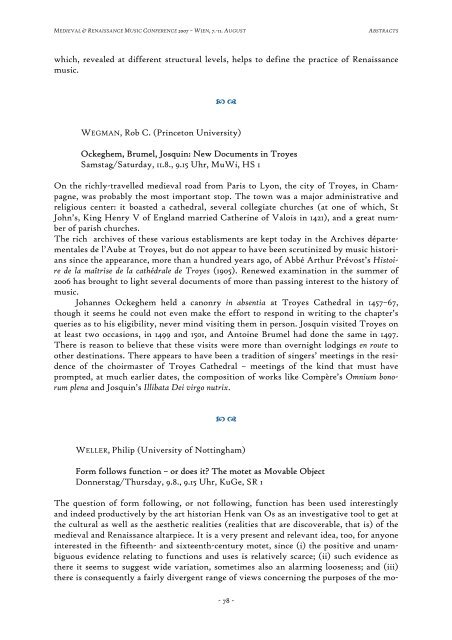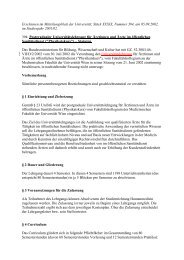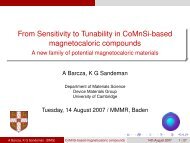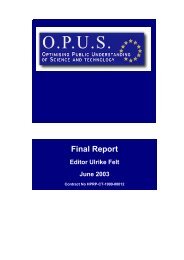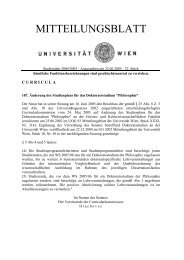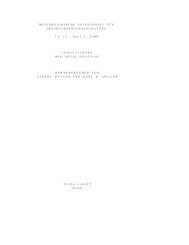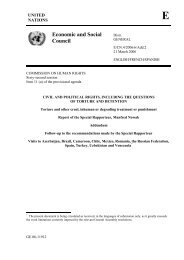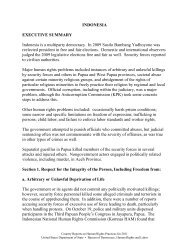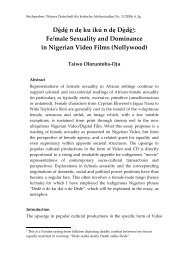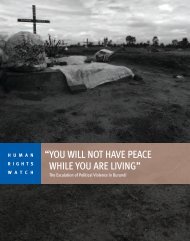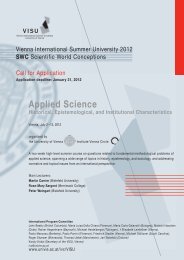(Stand: 25. Juli 2007) ANDERSON, Michael Alan ... - Universität Wien
(Stand: 25. Juli 2007) ANDERSON, Michael Alan ... - Universität Wien
(Stand: 25. Juli 2007) ANDERSON, Michael Alan ... - Universität Wien
Create successful ePaper yourself
Turn your PDF publications into a flip-book with our unique Google optimized e-Paper software.
MEDIEVAL & RENAISSANCE MUSIC CONFERENCE <strong>2007</strong> – WIEN, 7.-11. AUGUST ABSTRACTS<br />
which, revealed at different structural levels, helps to define the practice of Renaissance<br />
music.<br />
� �<br />
WEGMAN, Rob C. (Princeton University)<br />
Ockeghem, Brumel, Josquin: New Documents in Troyes<br />
Samstag/Saturday, 11.8., 9.15 Uhr, MuWi, HS 1<br />
On the richly-travelled medieval road from Paris to Lyon, the city of Troyes, in Champagne,<br />
was probably the most important stop. The town was a major administrative and<br />
religious center: it boasted a cathedral, several collegiate churches (at one of which, St<br />
John’s, King Henry V of England married Catherine of Valois in 1421), and a great number<br />
of parish churches.<br />
The rich archives of these various establisments are kept today in the Archives départementales<br />
de l’Aube at Troyes, but do not appear to have been scrutinized by music historians<br />
since the appearance, more than a hundred years ago, of Abbé Arthur Prévost’s Histoire<br />
de la maîtrise de la cathédrale de Troyes (1905). Renewed examination in the summer of<br />
2006 has brought to light several documents of more than passing interest to the history of<br />
music.<br />
Johannes Ockeghem held a canonry in absentia at Troyes Cathedral in 1457–67,<br />
though it seems he could not even make the effort to respond in writing to the chapter’s<br />
queries as to his eligibility, never mind visiting them in person. Josquin visited Troyes on<br />
at least two occasions, in 1499 and 1501, and Antoine Brumel had done the same in 1497.<br />
There is reason to believe that these visits were more than overnight lodgings en route to<br />
other destinations. There appears to have been a tradition of singers’ meetings in the residence<br />
of the choirmaster of Troyes Cathedral – meetings of the kind that must have<br />
prompted, at much earlier dates, the composition of works like Compère’s Omnium bonorum<br />
plena and Josquin’s Illibata Dei virgo nutrix.<br />
� �<br />
WELLER, Philip (University of Nottingham)<br />
Form follows function – or does it? The motet as Movable Object<br />
Donnerstag/Thursday, 9.8., 9.15 Uhr, KuGe, SR 1<br />
The question of form following, or not following, function has been used interestingly<br />
and indeed productively by the art historian Henk van Os as an investigative tool to get at<br />
the cultural as well as the aesthetic realities (realities that are discoverable, that is) of the<br />
medieval and Renaissance altarpiece. It is a very present and relevant idea, too, for anyone<br />
interested in the fifteenth- and sixteenth-century motet, since (i) the positive and unambiguous<br />
evidence relating to functions and uses is relatively scarce; (ii) such evidence as<br />
there it seems to suggest wide variation, sometimes also an alarming looseness; and (iii)<br />
there is consequently a fairly divergent range of views concerning the purposes of the mo-<br />
- 78 -


